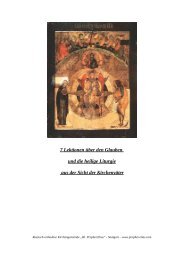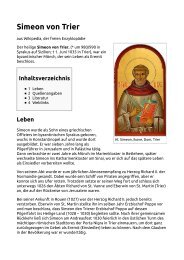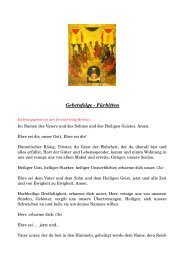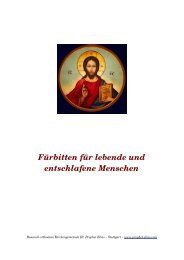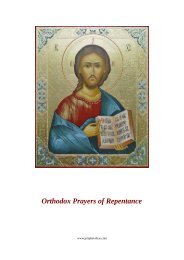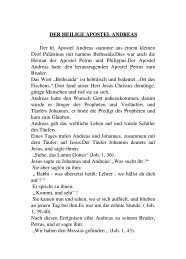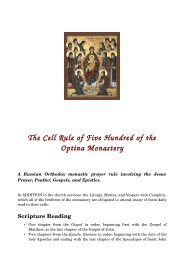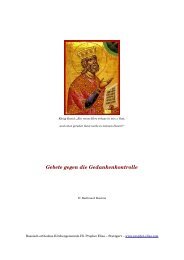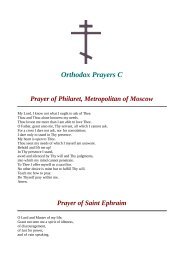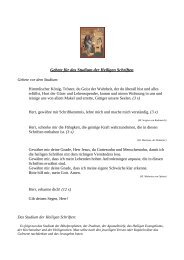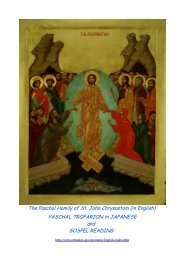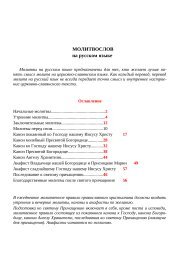The Monastic Tonsure
The Monastic Tonsure
The Monastic Tonsure
You also want an ePaper? Increase the reach of your titles
YUMPU automatically turns print PDFs into web optimized ePapers that Google loves.
<strong>The</strong> <strong>Monastic</strong> <strong>Tonsure</strong>It is generally accepted that monasticism began in Egypt towards the end of the ThirdCentury, though its origins may have been older. Indeed, some form of monasticism mayhave existed almost from the birth of the Church. As the word monastic implies (in Greekmonos alone), the Monk was one who went into the desert to live alone with God. (Such werealso called hermits (or anchorites), which means solitaries.) <strong>The</strong> first recorded hermiticOrthodox Christian literature was St. Paul of <strong>The</strong>bes ( 341) who lived over sixty years in acave in the Egyptian desert. But the greatest of these hermits, often called the Father of<strong>Monastic</strong>ism, was St. Anthony the Great ( 356). Yet, even in the life of this father ofmonasticism, the desert solitude was gradually modified by the appearance of disciples.<strong>The</strong>se men wished to pursue the monastic life under the guidance of one who was alreadyexperienced. A soldier marching into battle would much rather be commanded by anexperienced officer than an inexperienced one, no matter how educated the latter may be.Nor, if he himself is inexperienced, would he wish to enter the battle alone. Thus, afterstruggling many years as a solitary, St. Anthony gathered to himself a community of Monkswho lived in separate huts, each working out his own salvation in his own particular way, butunder Anthony's supervision, guided by his great experience in spiritual life.Anthony knew, however, the difficulties of the solitary life and he strongly approved of theestablishment of the coenobitic or common life, as it was perfected by another Egyptianfather, St. Pachomius the Great (348). In his coenobitic communities the Monks all livedtogether in one place, everything being held in common (there being no private property),and the individual Monk was under the strict supervision of a spiritual elder (or starets in thiscase Pachomius himself). <strong>The</strong>re were still solitaries inhabiting the surrounding desert, andsometimes the elder would himself choose to live more frequently in the desert than in themore populated central community.Eventually the central community became the norm of monasticism and the solitary life theexception. Whenever we see examples of solitary monastic life in later Saint's lives, we see itentered into almost exclusively by those who had already acquired considerable experience incommunal monastic life. Even as great an ascetic as Saint Seraphim of Sarov pleaded for along time before he was given permission to withdraw into the forest outside of hismonastery in order to pursue the solitary life. Thus, in time, the communal, coenobitic formbecame the preferred form of Orthodox monasticism and thus, the overwhelming majority ofOrthodox monastic communities in the world today are coenobitic communities.In a coenobitic monastery each of the Monks live in a separate room, called a cell, wherein hesleeps and performs his private rule of prayer (the cell-rule) given to him by his elder. All ofthe Monks assemble together for the Divine Services, for the common meals (or trapeza) inthe Refectory (often called the Trapeza or Dining Hall) and in common work. <strong>The</strong> head of acoenobitic monastery is the Abbot (or Igumen (Hegumen), meaning leader) or, if themonastery were particularly famous, the higher ranking Archimandrite (chief of a fold). In
some monasteries under the direct supervision of the Primate of the Church (who is oftencalled, in such cases, the Great Abbot) a deputy will be appointed (called, in Russian,Namestnik or one who acts in the name of the Abbot Deputy Abbot).In the 14th Century, on Mt. Athos (a monastic republic which has existed on one of thepeninsulas of Greece since the 10th Century), there appeared a relaxed form of the coenobiticmonastery called the idiorrhythmic monastery (meaning personal way or manner) in whichmany of the communal rules were greatly altered. Monks were allowed to hold privateproperty, they often cooked for themselves in their own cells, and were not strictly requiredto attend all Divine Services as a community. This form of monasticism, for a time, heldsway on Mt. Athos, but at the present time only a minority of the monasteries there, and inthe world as a whole, are, in fact, idiorrhythmic.Another form of monastic life which developed was the skete life, so-called for the famousEgyptian community of Scetis which originated this form. <strong>The</strong> skete life has often beencalled the royal or middle path of monasticism, midway between the extreme rigors ofsolitary life and the common life. A skete, which in modern times is usually situated on thelands of a sovereign monastery, is, in effect, a small monastic village, consisting of a smallnumber of Monks living a stricter ascetical life prayer.Skete life can take one of two different forms: a) the idiorrhythm skete, which consists ofseparate houses surrounding a small church, in which the Divine Liturgy is usually served onSaturdays, Sundays and Feast Days. <strong>The</strong> Daily Services are said in a chapel to be found ineach house, and the general rules of monastic life are the same as in idiorrhythmicmonasteries (the holding of private property, etc.), and b) the coenobitic skete, which consistsof the common life typical of the coenobitic monasteries in a main house with Daily Servicescelebrated in common in the Skete church. As in the idiorrhythmic sketes, Divine Liturgy iscelebrated only on Saturdays, Sundays and Feast Days.Finally, there were also to be found hermitages on the monastery lands (and elsewhere),where those who had especially progressed in the monastic life were allowed to live assolitaries. In such cases the hermit was granted a food ration from the main monastery,usually brought to him by Monks of the monastery, for the hermit rarely, if ever, left hishermitage, where he spent his remaining earthly days in strict solitude and ceaseless prayer,just as had the ancient solitaries of Egypt, Palestine, Syria, and other places.Considering the predominance of coenobitic monasticism, if the origin of monasticism wasthe solitary life and the Monk is, by definition, alone, why, then, did monasticism becomeessentially communal? Why does the Church even seem to discourage those who would leada life of solitude? Is this not a departure from the essence of monasticism?<strong>The</strong> answer lies in that physical solitude is not the essence of monasticism, for this essence is,in fact, the struggle to cast out the very root of man's sinfulness: pride and self-will. <strong>The</strong> FirstSin was none other than the desire to live by man's own will rather than the will of God. Itwas the desire to be independent, to be as God in a manner that would free man from obeying
anyone but himself. This is the sin that caused the Fall of man and which is at the origin ofvirtually every sin we commit. I steal when my desire to possess surpasses all other thoughtsor reason. I lie when my desires overcome reality. I hate when someone stands in the way ofwhat I want. I do not pray when I am the center of my universe, and not God.Pride and self-will can be eradicated only through the acquisition of their opposites: humilityand obedience. A Monk leading a totally solitary life is rarely in a position to effectively testeither of these qualities. A humble attitude towards God is genuine only if accompanied byhumility towards fellow-men. Obedience to God is empty unless one is able to obey others.Instead of learning humility and obedience, the Monk who lives alone runs the serious risk offalling into a special form of pride, prelest, a Russian word sometimes translated as spiritualself-deception. <strong>The</strong> Monk takes pride in his ascetic labors, in his saintly manner of life and inthis state, he can be completely lost, since true monastic sanctity is always self-accusing,always mourning its sinfulness. <strong>The</strong> more severe the asceticism, the greater the danger ofprelest.Humility and obedience can best and most-safely be acquired through the total surrender ofthe Monk to an instructor experienced in the spiritual life. <strong>The</strong> Monk confesses even his mostintimate thoughts to his elder and does nothing without his blessing. <strong>The</strong> former teacheshumility, the latter teaches obedience.<strong>The</strong> problem of pride and self-will is, as we have said, common to all mankind. Obviously, itis not only Monks and Nuns who must struggle to replace them with humility and obedience.True monastic life, however, especially under the direction of an elder, is exceptionallyconducive to that particular struggle. <strong>The</strong> life of a Monk is specifically regulated to theacquisition of these virtues. Life outside the monastery, with its own responsibilities andpreoccupations, makes it difficult to discern the state of one's soul and concentrate on theacquisition of spiritual virtues.For this reason, Orthodox Christian men and women, clergy and laity, have been flocking tothe monasteries for over a millennium and a half. <strong>The</strong>y came to learn from those who are, ina sense, at the front line of battle. <strong>The</strong>y came to learn from the experienced, to obtain advicefor success and consolation in failure. <strong>The</strong>y were greeted with love, compassion, and deepunderstanding. <strong>The</strong>y learned that they were not alone in their struggles, that others hadsuffered as they did. <strong>The</strong>y returned to their homes strengthened, encouraged and wiser,better-equipped to continue the struggle in their own daily lives.And so, the goal of monasticism was not one of ego and self, but of love of God and thedesire to set aright the pernicious influences of pride, self-will and disobedience. <strong>Monastic</strong>life elevates a Monk to spiritual perfection in the light of Christ's love and, by living in thislove, bears light and spiritual warmth to the world. By withdrawing from the world, a Monkdoes not express contempt for it, but, on the contrary, acquires a perfect love for the world, apure love in Christ which is alien to worldly passions. By turning away from vanity the Monkstrives to perceive himself and his impotence, and to fortify himself spiritually through prayer
to God. And thus is was that it was to the monasteries that the faithful turned in order toacquire help and encouragement in their own daily spiritual struggles.Excerpt taken from "<strong>The</strong>se Truths We Hold - <strong>The</strong> Holy Orthodox Church: Her Life andTeachings". Compiled and Edited by A Monk of St. Tikhon's Monastery. Copyright 1986 bythe St. Tikhon's Seminary Press, South Canaan, Pennsylvania 18459.To order a copy of "<strong>The</strong>se Truths We Hold" visit the St. Tikhon's Orthodox SeminaryBookstore.



